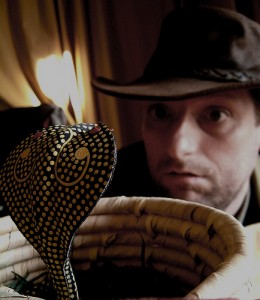Ophidiophobia is a fear of snakes that affects around 10% of the global population. Read and explore the various causes, symptoms, modes of treatment and more of this common phobia.
What is Ophidiophobia?
Page Contents
It is a specific type of phobia (anxiety disorder resulting in abnormal fear of any object or situation) where a person has morbid fear of snakes. It is also known as Ophiophobia. This kind of snake phobia can be a part of Herpetophobia, which is a fear of reptiles like lizards and amphibians. People suffering from Ophiophobia may develop secondary fear towards the other reptiles in the course of time.
Picture 1 – Ophidiophobia
Although the fear was earlier considered to be an innate reaction, recent medical research has revealed that it is a very critical medical condition.
The condition is also often referred to as “Snakeophobia”.
Ophidiophobia Etymology
The word Ophidiophobia is derived from the Greek words “Ophis” which means snakes and “Phobia” standing for fear. The fear usually arises either because of hatred towards snakes or due to the poison that it contains. Ophidiophobic people not only fear the sight of snakes but may even get petrified while thinking about them. Palpitation may start even if they see snakes on television or in pictures.
Ophidiophobia Facts
Go through some interesting facts associated with this disorder:
- A person who has a phobia of snakes typically gets scared even while thinking about such creepy creatures. He/she may be well informed on the facts about serpents and also know that not all snakes are poisonous. Despite this, the individual will always feel threatened at the sight or thought of snakes.
- Snakes tend to hide under or behind certain objects and can attack their prey from the back. The knowledge of this attacking method causes greater fear in that person.
- The slimy appearance of serpents, caused by dry scales covering their skin, is also a cause o hatred and fear in some people.
- The fact that a serpent does not have eyelids and is incapable of blinking also triggers fear in an Ophidiophobic person.
- A person with this phobia may display signs of a panic attack when gripped by fear of snakes. He or she may either become motionless or start panicking and running away from potential danger.
Ophidiophobia Causes
In most cases, the phobia is found to have a relation to a very dreadful past experience in the life of the patients. Such negative experiences are found to give rise to a long lasting fear. Sometimes, however, such fears are found to be imaginary and cannot be explained by any logic or proof. In such cases, patients have to do a self analysis and understand the reason of an aversion in their mind. Otherwise, it can lead to a nervous breakdown after a point of time.
Normally, the disorder ends to affect people who have:
- Acute fear and tension, either related to a person, thing, place or incident
- A tendency to easily get excited and nervous
- Adrenal insufficiency, where the adrenal glands (located above the kidney) do not produce sufficient amount of steroid hormones which regulate the functioning of organs in the body.
Ophidiophobia Symptoms
The symptoms of this disorder can be categorized into mental, emotional and physical. The magnitude of fear can be subtle which restricts to only large and venomous snakes. But it may turn into a more severe form where suffering individuals are found to be afraid of even smaller snakes.
Picture 2 – Ophidiophobia Image
Mental symptoms
Some of the primary mental symptoms of this disorder include:
- Erratic thoughts
- Constant thoughts of snakes only, which further aggravates the fear
- Mentally visualizing horrid images and visuals of snakes
- Occasional sensations of being depressed and lost in thoughts
- Unable to control fear and going berserk with panic
- Fear of losing consciousness
Emotional symptoms
Some of the main emotional signs and symptoms of the condition involve:
- Constant sensation of being tensed and disturbed about future encounters with snakes
- Persistent fear, which turns nerve-racking after a point of time
- Desire to run away from a spot, with or without the presence of a snake
Physical symptoms
The primary physical symptoms of this phobia include:
- Giddiness
- Trembling sensations
- Choking sensations
- Breathing difficulties
- Palpitations
- Uneasy feelings in the chest
- Perspiration (sweating)
- Nausea
- Vomiting sensations
- Stomach aches
- Feelings of haziness
- Lack of sensations or occasional shivering
- Cold or hot flushes
Ophidiophobia Diagnosis
Such phobias are diagnosed by an experienced healthcare professional, particularly a specialist or mental health therapist. Such professionals ask a set of questions to patients to understand all the symptoms that they are experiencing. The questions generally include:
- The patient’s reaction at the sight of snakes
- The duration of the prevalence of this phobia
- The frequency of appearance of the symptoms
- The length of duration of the patients thoughts about snakes during normal working hours
The phobia can be confirmed on the basis of the answers provided by patients. Doctors can use the information to consider whether or not sufferers require immediate medical assistance.
Ophidiophobia Treatment
The treatment of this phobia requires use of some commonly used drugs, such as:
Beta blockers
These are particularly used to obstruct the flow of adrenaline, which is responsible for causing anxiousness. Beta blockers are useful in curbing physical symptoms like perspiration, shivering and palpitation. However, these are unable to control emotional symptoms like irritability and tension.
Antidepressants
Antidepressant medications like Effexor, Paxil and Zoloft are explicitly administered in more serious cases. These are useful in cases where the phobia is more severe in intensity and can lead to very critical and harmful situations.
Benzodiazepines
These fast-acting medicines are normally used in cases that require speedier treatment and where other drugs are not effective. These anti-anxiety drugs may cause sedation and addiction in patients. Due to this reason, they are not generally recommended. The potential side-effects of these drugs make non-drug therapy a more preferable option.
Behavioral Therapy
Therapists usually conduct this type of therapy in one-to-one sessions with the patient. The principle behind this kind of therapy is gradual exposing patients to the object of fear in order to reduce the cause of anxiety. The amount of exposure is increased from session to session which may include live encounter with small snakes in a controlled environment. The therapist may even suggest the patient to change the way of thinking and to engage in some other useful activities.
Cognitive Behavioral Therapy
This treatment involves making patients perform certain exercises which can replace the negative pattern of their thoughts with positive ones. Such a therapy aids the patient to eradicate the root cause of the phobia completely from the mind.
Hypnosis
Also known as Hypnotherapy, it is often used to provide patients with Therapeutic relaxation.
Ophidiophobia is a disorder of the mind which can only be suppressed but not eradicated by drugs and medications. It needs proper behavioral modification and love and support from close ones to get rid of this complicated condition.
References:
http://en.wikipedia.org/wiki/Ophidiophobia
http://www.changethatsrightnow.com/ophidiophobia/
http://phobias.about.com/od/phobiaslist/a/ophidiophobia.htm


